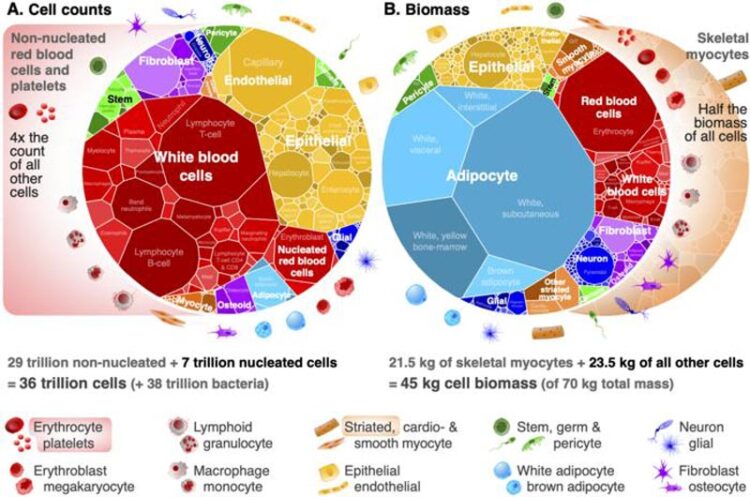Cellular cartography

A) The cell count is dominated by white blood cells, with approximately 3.4 trillion cells, most of which are located in tissues. B) Skeletal muscle cells and white adipocytes make up the bulk of the cellular biomass.
Credit: Ian Hatton
– charting the sizes and abundance of our body’s cells reveals mathematical order underlying life.
An international team of scientists has created the first comprehensive index of human cells, mapping the sizes and abundance of all cell types across the entire body. This groundbreaking study, published in PNAS, reveals surprising mathematical patterns underlying cell size and number, challenging our fundamental understanding of cell growth and proliferation.
Led by Dr. Ian Hatton of the Max Planck Institute for Mathematics in the Sciences, the researchers compiled an extensive dataset of over 1200 distinct cell groups. They estimated size ranges, mass, and cell counts for each group across 60 tissue systems in three reference humans – an adult man, woman, and child. “For the first time, we have systematically measured the size and abundance of cells across all major tissues and organs – spanning seven orders of magnitude from tiny red blood cells to large muscle fibers,” elaborated lead researcher Dr. Ian Hatton of the Max Planck Institute.
While many contemporary works focus on molecular profiling, this study adopts a classical cell biology approach, quantifying morphological features of known cell types. They integrated decades of histological and anatomical research to establish a holistic quantitative framework. The team discovered a striking near-inverse relationship between cell size and abundance, implying a trade-off between the two variables. Essentially, as cells get larger in size, their numbers decrease proportionately so that cells of all sizes contribute equally to the body’s biomass. This suggests there is no universally optimal cell size, but rather metabolic constraints and functional niches ensure that cells are efficiently “spread” across the entire size spectrum.
The researchers also found that cell size variability is largely constant across cell types, pointing to universal mechanisms regulating their size. “The body exhibits patterns reminiscent of natural laws governing many complex systems, from oceans to asteroids,” said Dr. Hatton. “A better grasp of these mathematical rules could reveal key principles of cell growth mechanisms relevant to developmental processes, cancer, regeneration, and aging.” The comprehensive cell index provides biologists with an invaluable reference to contextualize molecular studies and advance medical understanding. Widespread adoption of these data could positively affect drug development, medical diagnostics, and disease progression modeling.
“Our holistic map serves as a foundation to support the establishment of a human cell atlas with molecular resolution,” concluded Dr. Hatton. “With potential health applications, these findings underscore the importance of regarding cells in their physiological context as part of a complex but organized system.” To facilitate this sentiment, the team has made their extensive data accessible through an interactive online tool that allows the hierarchical exploration of cell parameters across tissues and cell types, while providing methods and sources for each cell type.
Journal: Proceedings of the National Academy of Sciences
DOI: 10.1073/pnas.2303077120
Method of Research: Data/statistical analysis
Subject of Research: Cells
Article Title: The human cell count and size distribution
Article Publication Date: 18-Sep-2023
Media Contact
All latest news from the category: Life Sciences and Chemistry
Articles and reports from the Life Sciences and chemistry area deal with applied and basic research into modern biology, chemistry and human medicine.
Valuable information can be found on a range of life sciences fields including bacteriology, biochemistry, bionics, bioinformatics, biophysics, biotechnology, genetics, geobotany, human biology, marine biology, microbiology, molecular biology, cellular biology, zoology, bioinorganic chemistry, microchemistry and environmental chemistry.
Newest articles

Artificial blood vessels could improve heart bypass outcomes
Artificial blood vessels could improve heart bypass outcomes. 3D-printed blood vessels, which closely mimic the properties of human veins, could transform the treatment of cardiovascular diseases. Strong, flexible, gel-like tubes…

NASA’s Fermi finds new feature in brightest gamma-ray burst yet seen
In October 2022, astronomers were stunned by what was quickly dubbed the BOAT — the brightest-of-all-time gamma-ray burst (GRB). Now an international science team reports that data from NASA’s Fermi…

Folded peptides are more electrically conductive than unfolded peptides
Researchers combined single-molecule experiments, molecular dynamics simulations and quantum mechanics to validate the findings published in PNAS. What puts the electronic pep in peptides? A folded structure, according to a…





















